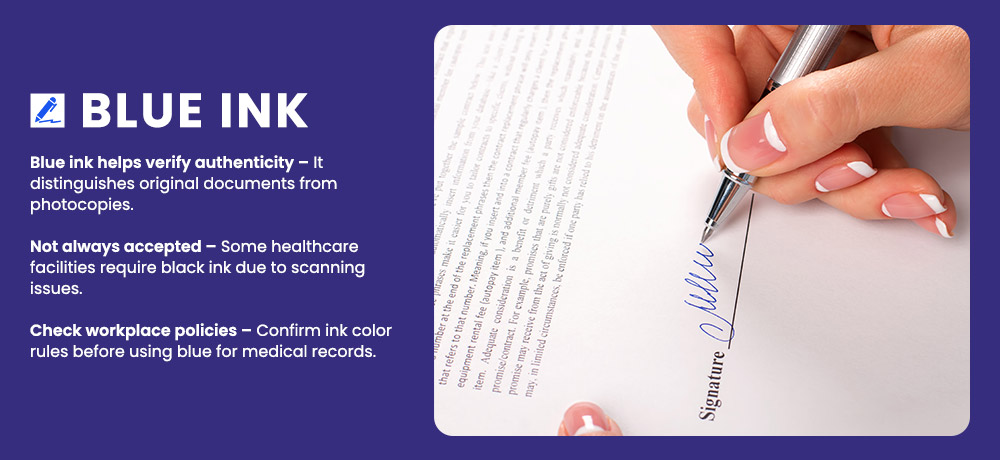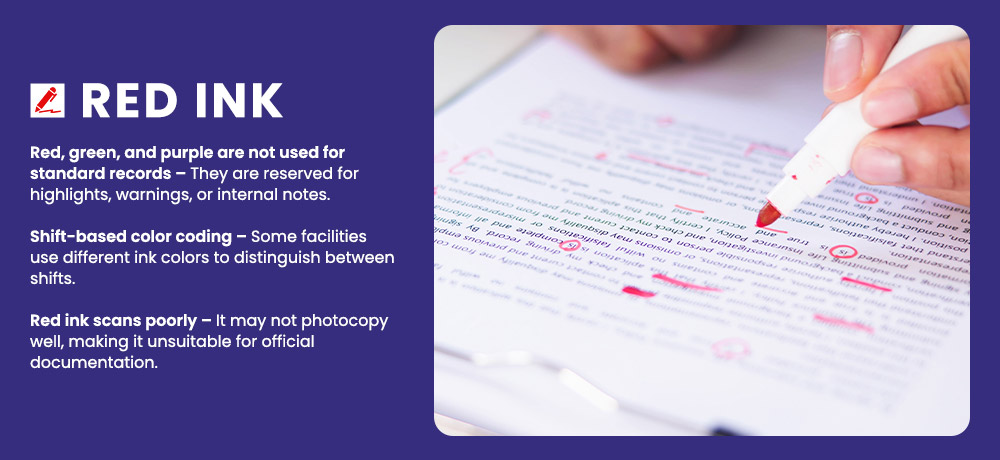Keeping clear and accurate medical records is important for patient care, legal protection, and smooth communication between healthcare providers.
Every detail in these records must be easy to read and legally valid. One small but important factor in medical documentation is the color of ink used.
The ink color can affect how readable a record is, whether it looks official, and how easy it is to prevent changes or fraud. But which color is best: blue, black, or something else?
In this blog, we’ll discuss the ink colors for medical records, why they matter, and which ones should you choose?
💡 What are Medical Records?
Medical records are organized, detailed documents that capture a patient’s health journey. They are like a simple health diary for each person. They hold important details, such as:
- The person’s name and birthday
- What health problems they’ve had
- What the doctor says is wrong
- How they plan to help
- What medicines they take
- Results from tests like blood work or X-rays
- Any surgeries they’ve had
- What they’re allergic to
- What shots they’ve gotten
For healthcare providers like you, these records allow you to track a patient’s progress, avoid medication errors, spot patterns in symptoms, and make informed decisions based on past interventions. By reviewing a patient’s record, you can quickly understand their chronic conditions, prior treatments, and risk factors, ensuring continuity of care across specialists, nurses, and other team members.
Most Preferred Ink Colors & Their Importance
The color of ink used in medical records matters more than most people realize. It affects how easy the records are to read, copy, and verify for legal purposes.
Some ink colors are easy to read and widely accepted, while others cause problems when scanned or copied.
Here are the ink colors most healthcare professionals prefer for medical records:
Black Ink – The Best Choice for Medical Records

Black ink is the preferred and most widely accepted choice for medical records. It is easy to read, creates a strong contrast against white paper, and scans or photocopies clearly.
Many hospitals, clinics, and legal institutions use black ink because it ensures consistency and avoids issues when records need to be stored or shared.
Since legal documents and court records also accept black ink, it is the safest and most reliable option for medical documentation.
Blue Ink – Top Choice for Signing Medical Records

Sometimes, medical practices use blue ink instead of black because it helps distinguish original documents from photocopies.
This can be useful in verifying whether a document is authentic. So it is best to use blue ink for signing the documents.
However, not all healthcare facilities accept blue ink for medical records. This shade may not scan well, so certain institutions have strict policies requiring black ink only.
If you’re considering using blue ink, it’s best to check the rules of your workplace first.
Red & Other Colors – for Special Use Only

Healthcare professionals generally do not use red ink, green, or purple for writing standard medical records. Instead, they reserve these colors for highlighting important information, such as allergies, urgent notes, or warnings.
While red ink can make important details stand out, it does not photocopy or scan well, making it a poor choice for official documentation. Other colors, like green or purple, may be used for internal notes but are not suitable for legal records.
Sometimes, medical practices use different ink colors for special purposes. For example, in facilities with three shifts, each shift’s medical staff uses a different ink color. This helps to distinguish between medical records created on the same day.
Rules on Ink Color (HIPAA, Medicare, and State Regulations)
The Health Insurance Portability and Accountability Act (HIPAA), Medicare, and state laws require medical records to be clear, legible, and permanent.
While no single federal rule specifies which ink to use, black or dark blue ink is recommended. These colors work best for scanning, copying, and long-term storage.
Problems with Using the Wrong Ink Color
Using the wrong ink color can cause serious issues, such as:
- Light or bright ink colors may not scan well, making it hard to store or read records. Making the records illegible over time.
- If medical records are unclear or altered, they may not be accepted in court.
- If a healthcare facility fails to meet documentation standards, it could face audits, fines, or loss of accreditation.
How to Stay Compliant?
To avoid issues, healthcare providers should establish clear guidelines requiring black or dark blue ink for all handwritten records.
They should also educate employees about proper documentation practices and the risks of using non-compliant ink colors.
Regular audits should be conducted to ensure that the staff follow these rules and maintain accurate, legally compliant records.
Common Mistakes & Best Practices
Here are the mistakes that a medical staff commonly commits while choosing ink color, along with tips on how you can change those into best practices:
➜ Choosing Ink That Lasts
Medical records must stay readable for years. Some inks fade, smudge, or disappear over time, making them unreliable.
To prevent this:
- Avoid gel pens and light ink as these may not last or scan well.
- Use permanent, water-resistant ink such as black or dark blue ballpoint pens are the best choice because they are long-lasting and clear.
➜ Keeping Consistency Across a Medical Facility
Using different ink colors can create confusion and inconsistency.
How can you ensure uniformity?
- Set clear guidelines by establishing a rule that only black or dark blue ink is used.
- Switch to electronic records (EHRs). Digital records reduce the need for handwritten notes and prevent ink-related issues.
- Assign someone to check that staff follow the ink color policy to monitor compliance.
➜ Training Staff on Proper Documentation
To avoid mistakes, staff should be well-trained in proper documentation practices. You can achieve this by educating new employees on ink guidelines during training.
You can conduct regular refresher sessions to keep staff updated on best practices, and placing visual reminders in work areas to reinforce proper ink use.

Conclusion
The color of ink used in medical records may seem like a small detail, but it plays a big role in keeping records clear, legal, and easy to access.
Black ink is the best choice because it is easy to read, scans well, and most people accept it in hospitals and legal settings.
Blue ink can help distinguish original documents from copies, but not all healthcare facilities allow it. You should use red and other colors only for special notes, such as warnings or shift identification.
Using the wrong ink can lead to problems, such as unreadable records, legal issues, and failure to meet healthcare regulations.
To avoid these risks, medical facilities should set clear rules requiring black or dark blue ink, train staff on proper documentation, and regularly check for compliance.
By following these best practices, healthcare providers can ensure that medical records remain accurate, professional, and legally valid, ultimately improving patient care and communication.





